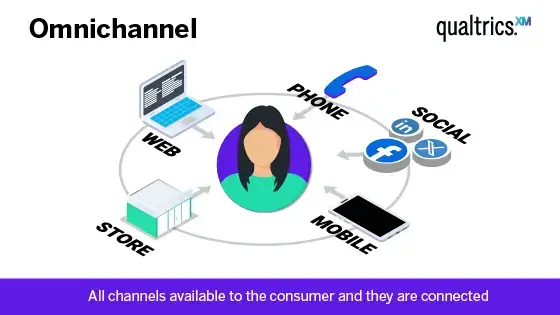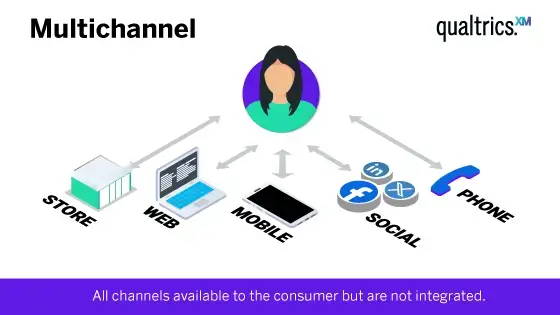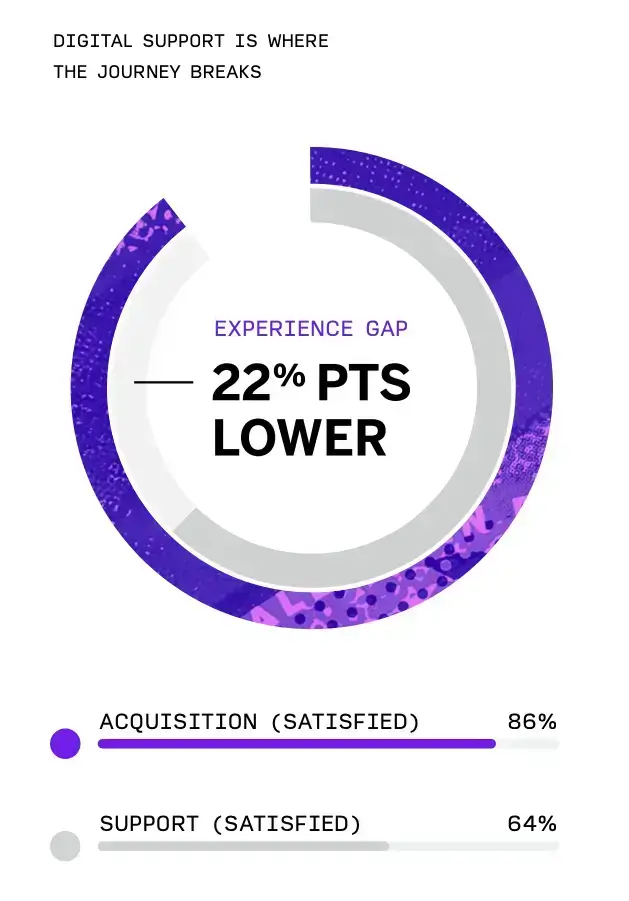
Today’s audiences are accustomed to engaging with brands on multiple channels. To stay relevant, businesses need to be able to successfully engage customers on various channels - but what’s the best approach to take? Read on to learn more about omnichannel vs. multichannel strategy and how to implement it for your business.
What is an omnichannel strategy?

An omnichannel strategy unifies multiple channel experiences and examines them from a holistic perspective. Rather than evaluating or offering customer engagement on a channel-by-channel basis, an omnichannel approach creates a seamless customer experience. Not only that, but it provides a more comprehensive view of the drivers of customer behavior, as data analysis takes place on a broader, more interconnected scale. It is a useful approach for businesses that have a large number of engagement channels with a customer base that requires fluent experiences cross-channel.
Example: Starbucks
Starbucks integrates its mobile app, loyalty program, and in-store experience to create a seamless customer journey. Customers can order and pay through the app, earn rewards, and receive personalized recommendations. The app also enables online ordering for in-store pickup. In-store, baristas greet regular customers by name and prepare their usual orders.
By blending digital and physical touchpoints, Starbucks has increased customer loyalty, spend per visit, and gained valuable insights into customer preferences.
Free eBook: Reimagining omnichannel CX in the age of AI
What is multichannel marketing and analytics?

A multichannel approach to customer experiences and marketing analysis treats channels as independent, with experiences contained to each channel. Multichannel marketing requires individual channel optimization, routing customers to the purchase stage on a journey specific to each channel.
Example: GAP Inc.
The parent company of GAP, Banana Republic, and Old Navy traditionally employed a multichannel strategy, with each brand having its own separate online store, mobile app, and physical retail locations. While customers could shop across these channels, experiences were not seamlessly integrated. For example, online stores did not have access to in-store inventory, and loyalty programs were separate for each brand. This lack of integration meant that customers had to manage multiple accounts and could not easily shop across brands.
Omnichannel vs multichannel strategy
While a multichannel strategy involves having a presence on multiple platforms, an omnichannel approach ensures that all channels work together seamlessly to provide a unified, customer-centric experience.
Omnichannel strategies recognize that customers expect to interact with brands on their preferred channels and move between them effortlessly during their buying journey.
In an omnichannel approach, the focus is on creating a consistent, integrated experience across all touchpoints, allowing customers to pick up where they left off on one channel and continue their journey on another. This requires breaking down silos between channels and ensuring that teams work together to deliver a cohesive brand experience.
By contrast, multichannel strategies often treat each channel as a separate entity, with little or no integration between them. While this approach may be a starting point for businesses, it can lead to a disjointed customer experience and missed opportunities for engagement and conversion.
The advantages of omnichannel strategy for customer engagement
The advantages of omnichannel marketing and experiences are numerous. Below are the key advantages of unifying your efforts across your marketing channels:
Increased customer satisfaction and loyalty
Customers are not a monolith. Depending on many factors, from demographic to psychographic, customers have preferences for the channels they use. For example, our research found that over 51% of consumers prefer digital channels rather than offline channels - but that leaves many consumers who would prefer to communicate via offline channels out of the experience loop.
When your business provides your audience with multiple opportunities for cohesive, personalized customer engagement, there is a higher percentage chance that your audience will proceed along the sales funnel to make a purchase. Instead of hoping that customers will find the experience that resonates with them on each individual channel, instead your omnichannel marketing and customer experience strategy will provide better opportunities for customer engagement and conversions.
Improved sales and revenue
According to Google, 90% of marketers say personalization significantly contributes to business profitability. As customers increasingly expect personalized experiences, businesses that don’t keep up are likely to lose out on sales and revenue. By creating a customer journey that reflects customer preferences and habits, your business can improve the chances of customers completing purchases and returning to purchase more in future.
Better customer lifetime value
Customers that feel individually seen and personally supported by brands are more likely to return and repurchase. This is particularly true when it comes to the support they get across your digital channels. Our latest research has found that consumers are 2.7x more likely to come back to a brand after a positive digital support experience, but that at present, digital support generally only has a 64% satisfaction rate. There is plenty of opportunity to stand out in the market by providing excellent digital experiences, particularly when they feel cohesive and personalized. Many brands focus solely on the acquisition experience, but less on the ongoing support - make your business stand out by offering an omnichannel approach that nurtures customers continually.

Increased efficiency and cost savings
By integrating systems and processes across channels, businesses can streamline operations, reduce redundancies, and lower costs associated with managing separate channel strategies.
A better competitive advantage
As more consumers expect seamless, personalized experiences across channels, businesses that successfully implement an omnichannel strategy can differentiate themselves from competitors and build a loyal customer base.
The disadvantages of multichannel strategy
Though many businesses start with a multichannel strategy due to resource and technology limitations, there are issues to using a multichannel marketing and analysis approach. For example:
Customer experiences can become inconsistent
Without a defined link between one channel to another, a multichannel strategy can begin to form rifts in customer experiences. For example, if a customer is accustomed to a particular experience on one channel but doesn’t receive the same treatment on another, it can be jarring to move across instead of offering a unified, consistent brand experience. Consistency is critical to encourage customers to continue coming back to your brand time and time again, as they know what to expect.
Measuring performance is difficult
When marketing efforts and experiences are siloed from channel to channel, it becomes difficult to measure what campaigns have been successful overall. For example, a multichannel approach might mean that customers are moving from channel to channel, but there isn’t a way to track this movement. It is hard to optimize experiences to meet and exceed customer expectations when there isn’t a way to clearly see what drives customer behavior and which actions perform the most successfully.
Integration between channels is weaker
A seamless customer journey means that there are smooth integrations between channels. If experiences are designed solely for each channel, the overall experience from channel to channel can suffer. This can lead to customers feeling negative about your brand as their expectations aren’t met. Multichannel strategies, while initially a good place to start, can negatively impact customer experiences as a result of this weak integration.
Difficulty in creating a unified brand voice
When each channel operates independently, it can be challenging to maintain a consistent brand voice and messaging across all touchpoints. This can lead to confusion and erosion of brand identity in the eyes of the customer.
Inefficient resource allocation
With each channel operating independently, businesses may end up duplicating efforts and inefficiently allocating resources. This can lead to higher costs and reduced agility in responding to customer needs and market changes.
How to create successful omnichannel customer experiences
To develop better customer relationships via an omnichannel strategy, your team will need to consider the entire customer journey from every touchpoint. Whether they are accessing your brand through physical retail stores or digital sales channels, providing personalized customer experiences requires accurate data and careful planning to execute.
Here are some suggested steps for creating a seamless omnichannel experience:
Collect vital customer data
Customer preferences for each particular channel - and how they’d like to move in between each channel - can be gleaned from the collection and analysis of customer data. Collecting data from all channels allows your teams to examine all points of entry to the customer journey, and to understand what drives customers from one channel to another. With the right customer experience management platform, collecting and analyzing data from multiple channels is an automatic, streamlined process.
Identify key customer moments and touchpoints
Where are your customers most likely to make a purchase? How can you propel them through the customer journey to reach that point? By thoroughly analyzing your customer data, you’re able to surface insights into your customers’ habits and behavior and pinpoint key moments that lead to a purchase or sign up. Identifying where friction occurs and what obstacles stand in the way between discovery and purchase is made easier by taking a holistic overview of your customers’ interactions with your brand on all channels.
Deliver insights to key team members
Of course, it’s not enough to just collate data and create a customer journey map - you’ll also need to deliver the insights you gain to the relevant teams. Your data and the insights you’ve surfaced must be accessible to any teams who might need it, such as product development, customer service teams and more. The more information you can share between the teams that affect customer experiences, the better.
Create experiences that link multiple channels
Once you understand who your customers are, which channels they prefer and what inspires them to complete a purchase or sign up, you can create cohesive experiences that link multiple channels. Your team will need to interrogate the data to ensure you can predict the future behavior of customers to create seamless experiences.
For example, if you advertise a particular product on social media and enable sales on your website because your customers prefer digital channels, will those same customers prefer to speak to a person on the phone (offline) to resolve an issue they have post-purchase? Do they expect the same branding, tone of voice and customer service on all three channels? Are they likely to purchase the product if you do not offer multiple avenues of support post-purchase?
Unifying separate channels with a common brand experience ensures your customers engage with and recognize your brand, no matter where they encounter it. It also means handling post-purchase interactions is easier, as your teams aren’t limited by channel.
Recognize customers across channels
To create a seamless omnichannel experience, identify and recognize customers as they move between channels by linking interactions from multiple touchpoints to a single customer profile. Implement cross-channel identification techniques, such as unified customer IDs or authentication systems, to accurately track and attribute each customer's journey to their unique profile.
Expand customer profile data with cross-channel behaviors
Enrich customer profiles by collecting and analyzing behavioral data from across all channels, including website visits, product views, purchases, and customer service interactions. Combine this cross-channel behavioral data with traditional customer attributes to gain a more complete understanding of each customer's preferences, needs, and potential value, which serves as the foundation for delivering personalized experiences at every touchpoint.
Target and retarget customers
The beauty of an omnichannel approach is that you can target and retarget the same customers, utilizing all the data you have found and analyzed on multiple channels. For example, if a customer has browsed your website and found a product but not taken the steps to purchase, you can retarget them with a product advert on social media channels they frequent. The opportunities for reaching out and engaging customers on various channels increase when you are able to see customers’ journeys and behavior from an all-encompassing view.
The challenges of creating an omnichannel strategy
Though an omnichannel marketing strategy might be more effective at winning over customers, there are challenges to implementing a wider-ranging approach to a customer journey. Here are some of the key barriers to creating a consistent customer experience:
Data integration and management
Omnichannel strategies rely on the ability to collect, integrate, and analyze data from multiple sources and channels. This requires a robust data management infrastructure that can handle large volumes of structured and unstructured data. Ensuring data quality, consistency, and security across various systems and touchpoints can be a significant challenge, especially for organizations with legacy systems or disparate data sources.
Inadequate technology
One of the main limiters for engaging in omnichannel strategies is the technology used to develop, maintain and analyze a comprehensive customer journey that takes multiple channels into account. Legacy technology may require updating or integrations with new technology to ensure all data is captured and analyzed correctly. Tracking customer movement between two or more channels, such as a brick and mortar store all the way to digital channels, will require technology that can accurately tag and follow individual customers’ behavior. A comprehensive digital experience management system can automatically flag and track customers across all platforms.
Complex journey orchestration and management
Creating a customer experience that spans multiple channels can quickly become complex. Orchestrating and managing these experiences, as well as parsing and pulling insights from the large quantities of data you need to collect, can be difficult. Utilizing a suitable customer experience management tool that can automatically source and surface insights can help to alleviate this difficulty.
Organizational silos
Many organizations have separate teams managing different channels, such as e-commerce, social media, and brick-and-mortar stores. These silos can hinder the development and execution of a unified omnichannel strategy. Breaking down these silos and fostering cross-functional collaboration is essential for creating a seamless customer experience, but can be challenging due to entrenched organizational structures and processes.
Resource and skill requirements
Implementing an omnichannel strategy often requires significant investments in talent and training. Organizations may need to hire new staff with specialized skills in data analysis, customer experience design, and marketing automation. Existing employees may also require training to adapt to new processes and technologies. Allocating adequate resources and budgets to support these requirements can be challenging, particularly for smaller organizations or those with limited resources.
Measuring success and attributing value
Measuring the success of an omnichannel strategy can be difficult, as customer journeys span multiple touchpoints and channels. Attributing value to specific channels or interactions becomes more complex in an omnichannel environment. Developing appropriate metrics and attribution models that accurately reflect the impact of omnichannel initiatives on business outcomes requires careful planning and ongoing refinement.
Optimize your omnichannel analytics with Qualtrics®
Create memorable customer experiences with a successful omnichannel marketing strategy, developed with the support of powerful analytics provided by Qualtrics Frontline Digital™.
However customers choose to get in touch or access your brand, you are able to blend experience data and behavioral cues to create a comprehensive map of the end-to-end customer journey.
Empower your teams to engage customers at the right times to remove friction and optimize their journey from first touchpoint to lifetime customer. Gain a holistic view of the customer journey with the combination of experience data (X-data) and operational data (O-data), giving you insights into key moments and areas for improvement.
With enriched customer profiles that don’t depend on third party data, you’re able to build customer journeys and experiences that resonate. Connecting all your channels to one platform ensures that no matter the platform, your team is able to connect deeply in real time with customers wherever they choose to engage. Automate insights to offer your customers personalized experiences based on their unique needs and preferences.
By leveraging Qualtrics Frontline Digital, you can break down data silos, gain a unified view of the customer, and deliver seamless, personalized experiences across all channels, ultimately driving better business outcomes and fostering long-term customer loyalty.
Free eBook: Reimagining omnichannel CX in the age of AI